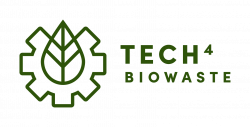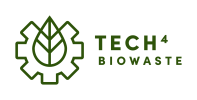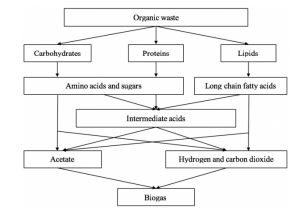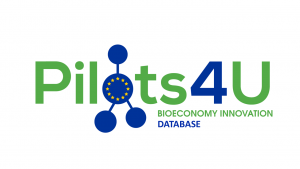Anaerobic digestion
| Technology | |

| |
| Technology details | |
| Name: | Anaerobic digestion |
| Category: | Conversion (Biochemical processes and technologies) |
| Feedstock: | Biowaste in general, Food waste, Garden and park waste (wood, leaves) |
| Product: | Biogas and digestate |
Anaerobic digestion is a process through which micro-organisms break down organic matter, such as animal manure, wastewater biosolids, and food wastes, in the absence of oxygen. Anaerobic digestion intended for biogas production takes place in a sealed tank (called an anaerobic digester), which is designed and constructed in various shapes and sizes specific to the site and feedstock conditions. These sealed vessels contain complex microbial communities that break down the waste and produce biogas and digestate (i.e., the solid and liquid material end-products of the process). The biogas can be used as a source of energy. The remaining digestate can be used as a fertiliser, or it can be post-treated according to its intended use, e.g. by drying or composting to use it as a soil improvement agent.
Feedstock
Origin and composition
Multiple organic materials can be combined in one digester, a practice called co-digestion. Co-digested materials include, amongst others, manure, food waste, energy crops, crop residues, and fats, oils, and greases (FOG) from restaurant grease traps.
Pre-treatment
Biomass is first separated from impurities as stones and glass. An agitator provides a good mixing between different biomass types to avoid strong changes in composition. The feed is a stirrable mixture and the dry matter content may be a maximum of 15-20% of the slurry. Co-substrates are often reduced in size by shredding before they are fed in order to make the contact surface of the biomass as large as possible.
For residual flows from the food industry, crop residues and manure, thermal and chemical pre-treatments are mainly applied. The most important effects of thermal pre-treatment are: reducing particle size, increasing solubility and improve the biodegradability. Additional advantages of thermal pre-treatment are: (1) higher loading of the digester is possible, (2) lower viscosity of the treated material which results in lower energy input for mixing the digester, (3) improved dewaterability of digestate and (4) sanitised product.
The following pre-treatments may be considered :
- Membrane filtration
- Sieving
- Sizing (e.g. chipping, grinding)
- Thermal pre-treatment
Process and technologies
Process
There are three basic anaerobic digestion processes, namely psychrophilic, mesophilic, and thermophilic, which take place over different temperature ranges. Psychrophilic digestion is a low temperature (<20°C) process. Mesophilic digestion takes place between 20 and 45°C, which can take a month or two to complete, and thermophilic digestion between 45 and 65°C, which is faster, but its micro-organisms are more sensitive. The majority of the agricultural biogas plants are operated at mesophilic temperatures. Thermophilic temperatures are applied mainly in large-scale centralised biogas plants with co-digestion[1]. The process of anaerobic digestion takes place through four successive stages: hydrolysis, fermentation, acetogenesis, and methanogenesis.[2] In the hydrolysis step, the feedstock is broken down into soluble substrates (e.g., sugar and amino acids) by enzymes. Fermentation involves the conversion of sugar, amino acids, and fatty acids into ammonia, organic acids, hydrogen (H2) and CO2. In the acetogenesis step, volatile fatty acids are broken down into acetic acids, CO2 and H2. Finally, methanogenesis step converts acetate, formaldeyde, and H2 to CH4 and water[3].
Usually, the produced biogas must be dried and drained for condense water and biological or chemical cleaned for H2S, NH3 and trace elements. Further upgrading of the biogas to increase the CH4 content could be realized by membrane separation of CO2 and pressurising the biogas.
A main distinction between anaerobic digestion (AD) technologies for treatment of municipal and industrial biodegradable wastes is the operating process solids content. Wet AD systems operate at low total solids (<10–20% TS) and dry systems have high operating solids (20–>40% TS).[4]
Product
Anaerobic digestion produces two valuable outputs, namely biogas and digestate. Biogas is composed of methane (CH4), which is the primary component of natural gas, at a relatively high percentage (50 to 75%), carbon dioxide (CO2), hydrogen sulfide (H2S), water vapor, and trace amounts of other gases. The energy in biogas can be used like natural gas to provide heat, generate electricity, and power cooling systems. Biogas can also be purified by removing the inert or low-value constituents (CO2, water, H2S, etc.) to generate renewable natural gas (RNG). This can be sold and injected into the natural gas distribution system, compressed and used as vehicle fuel, or processed further to generate alternative transportation fuel or other advanced biochemicals and bioproducts.
The digestate can be used in many beneficial applications provided that is is appropriately treated post processing. This could be in form of animal bedding, nutreint-rich fertilizer, organic-rich compost, or as soil amendment.
Post-treatment
The remaining digestate can be post-treated according to its intended use, e.g. by drying or composting to use it as a soil improvement agent.
Technology providers
| Company name | Country | Technology subcategory | Technology name | TRL | Capacity [kg/h] | Processable mass [kg] | Temperature [°C] | Feedstock: Food waste | Feedstock: Garden & park waste | Product: biogas | Product: Renewable natrual gas (RNG) |
|---|---|---|---|---|---|---|---|---|---|---|---|
| Biogas Plus | The Netherlands | - | Compact Plus | 9 | - | - | - | ● | |||
| Biorenewables Development Centre | United Kingdom | - | Anaerobic digestion | 4 | - | - | - | ● | ● | ||
| BioRenGaz | France | - | Bioreactor | 7 | - | - | - | ||||
| Dranco | Belgium | DRANCO Dry anaerobic digestion | - | 5000 | - | - | ● | ||||
| Planet Biogas | Germany | - | PlanET | 9 | - | - | - | ● | ● | ● |
Biogas Plus
| General information | |||
| Company: | Biogas Plus | 
| |
| Country: | The Netherlands | ||
| Contact: | |||
| Webpage: | https://www.biogasplus.nl | ||
| Technology and process details | |||
| Technology name: | Compact Plus | Technology category: | Conversion (Biochemical processes and technologies) |
| TRL: | 9 | Capacity: | 18.000 tons (input), 320.000 Nm3 green gas/year (output). kg·h-1 |
| Atmosphere: | Catalyst: | ||
| Pressure: | bar | Reactor: | Complete mix digester |
| Other: | |||
| Feedstock and product details | |||
| Feedstock: | Animal Manure | Product: | Green gas |
Biogas Plus is a turnkey supplier of biogas installations. This biogas installation produces biogas through the fermentation of organic (residual) flows, such as manure, unpacked food, sewage treatment sludge or other products. The biogas is then upgraded to renewable gas (green gas / biomethane / RNG) or to green electricity and heat. Biogas Plus offers a variety of installation sizes able to meet the needs of a mid-size farm up to large-scale units (between 50.000 and 300.000 tons of input per year).
Biorenewables Development Centre
| General information | |||
| Company: | Biorenewables Development Centre | ||
| Country: | UK | ||
| Contact: | Deborah Rathbone | ||
| Webpage: | https://www.biorenewables.org/ | ||
| Technology and process details | |||
| Technology name: | anaerobic digestion | Technology category: | Conversion (Biochemical processes and technologies) |
| TRL: | 4 | Capacity: | kg·h-1 |
| Atmosphere: | Catalyst: | ||
| Pressure: | bar | Reactor: | up to 30L |
| Other: | |||
| Feedstock and product details | |||
| Feedstock: | food waste, agricultural wastes, industrial wastes | Product: | |
The Biorenewables Development Centre )BDC) has anaerobic digestion (AD) facilities that enables new/potential users of AD to characterise their feedstock to establish its suitability for production of high biomethane yields, and also help existing users of AD systems to test modifications or additions to their system. Our facilities comprise;
- Custom built low (3-5%) and high (~25%) solids contents systems: 30 L reaction volume; pH- and temperature-controlled stirred digester units with integral dewatering system to facilitate the continuous addition of high volumes of dilute feedstocks.
- 24 unit biomethane potential analysis (BMP) system
- Hach Lange BOD Trak II for biochemical oxygen demand (BOD) analysis
- Hach Lange DR3900 spectrophotometer with HT200 high temperature / high speed digestion unit for measurement of chemical oxygen demand (COD), organic acids, nitrogen, chloride etc
- A range of Hewlett Packard and SRI gas chromatography systems (TCD, FPD, FID and Methanizer detection systems) to measure gas composition
- Thermolyne muffle furnace
- Kern moisture balance
- Hach Lange TOC5 shaker
- Hach Lange Titralab AT1000 titration system
- Portable pH, DO and conductivity systems
- Robot Coupe Blixer 10 VV for sample homogenisation
- Gas detection / oxygen depletion detection system
BioRenGaz
| General information | |||
| Company: | BioRenGaz | ||
| Country: | France | ||
| Contact: | contact@biorengaz.com | ||
| Webpage: | https://www.biorengaz.com/ | ||
| Technology and process details | |||
| Technology name: | Bioreactor | Technology category: | Conversion (Biochemical processes and technologies) |
| TRL: | 7 | Capacity: | kg·h-1 |
| Atmosphere: | Catalyst: | ||
| Pressure: | bar | Reactor: | |
| Other: | |||
| Feedstock and product details | |||
| Feedstock: | Product: | ||
BioRenGaz has developed a new patented anaerobic digestion technology that is 4 times more efficient and much more compact than conventional biogas plants thanks to vertical silo design. The anaerobic filter uses a recycled and 100% renewable packing material to replace costly and polluting plastic packing. This medium provides an ecological habitat for the bacteria and enhances their performance. The solution is adapted for the treatment of liquid effluents and the great advantage, unlike other technologies, is that it can also valorize pulpy effluents like biowaste pulp. The bioreactors have lower operational costs and increased energy production by keeping the micro-organisms on the packing material, which allows producing 10% more biogas. The system is modular, so bioreactors can be built from a small scale and easily be expanded as needed. The Solution aims for the optimization of the economic and environmental model of energy and agronomic recovery of biowaste.
Dranco
| General information | |||
| Company: | DRANCO nv | 
| |
| Country: | Belgium | ||
| Contact: | Bruno Mattheeuws (bm@dranco.be) | ||
| Webpage: | https://www.dranco.be | ||
| Technology and process details | |||
| Technology name: | DRANCO Dry anaerobic digestion | Technology category: | Conversion (Biochemical processes and technologies) |
| TRL: | Successful Deployment | Capacity: | >5000 kg·h-1 |
| Atmosphere: | Catalyst: | ||
| Pressure: | bar | Reactor: | 2500-5000m³ |
| Other: | |||
| Feedstock and product details | |||
| Feedstock: | biowaste, SSO, MSW, residual waste, ... | Product: | Digestate and/or high quality compost + biogas |
DRANCO nv has developed innovative and patented designs for biogas plants, with a pretreatment, digester concept and post-treatment adapted to each type of feedstock. Find out about our 30+ years of experience and our 35 references!
PlanET Biogas Group GmbH
| General information | |||
| Company: | PlanET Biogas Group GmbH | 
| |
| Country: | Germany | ||
| Contact: | |||
| Webpage: | https://www.planet-biogas.com | ||
| Technology and process details | |||
| Technology name: | PlanET | Technology category: | Conversion (Biochemical processes and technologies) |
| TRL: | 9 | Capacity: | kg·h-1 |
| Atmosphere: | Catalyst: | ||
| Pressure: | bar | Reactor: | Complete mix digester (modular) |
| Other: | |||
| Feedstock and product details | |||
| Feedstock: | Animal manure, biogenic waste materials | Product: | Green gas, heat & electricity |
PlanET anaerobic digestion (AD) plants can convert almost all biogenic waste materials into energy, such as slaughterhouse waste, fish processing residuals, animal carcasses, expired food or off-specification batches used in food production as well as agricultural residues, fats and oils. PlanET Biogas’ portfolio covers the whole range of biogas technology and utilization: feeding technology, safety technology, energy concepts, hygienisation, and gas upgrading. PlanET Biogas offers its technology turn-key and provides all after-sale services including biological assistance as well as service and maintenance for all technical equipment. PlanET Biogas has completed 600 AD plants worldwide, from 40 kW liquid manure systems to 3 MW waste to energy plants.
Open access pilot and demo facility providers
Here we make the link to the Europe-wide network & database of open access multipurpose pilot and demo infrastructures for the European bio-economy.
If you are looking for shared facilities that exist for the technology of anaerobic digestion, here is the link to the selection from the Pilots4U database : Pilots4U Database
Patents
Currently no patents have been identified.
References
- ↑ , 2021: Anaerobic digestion 2021, Last access 6/9/2021. https://www.eubia.org/cms/wiki-biomass/anaerobic-digestion/
- ↑ Junye Wang, 2014: Decentralized biogas technology of anaerobic digestion and farm ecosystem: opportunities and challenges. Fronties in Energy Research, Vol. 2, . doi: https://doi.org/10.3389/fenrg.2014.00010
- ↑ Jay N. Meegoda, Brian Li, Kush Patel, Lily B. Wang, 2018: A review of the Processes, Parameters, and Optimization of Anaerobic Digestion. International Journal of Environmental Research and Public Health, Vol. 15, . doi: https://doi.org/10.3390/ijerph15102224
- ↑ Eleni Angelonidi, Stephen R. Smith, 2015: A comparison of wet and dry anaerobic digestion processes for the treatment of municipal solid waste and food waste 09/11/2015, Last access 09/03/2023. https://onlinelibrary.wiley.com/doi/abs/10.1111/wej.12130#:~:text=A%20main%20distinction%20between%20anaerobic,%E2%80%93%3E40%25%20TS).

